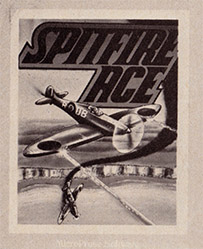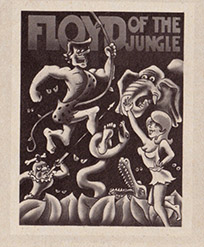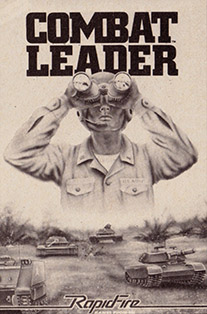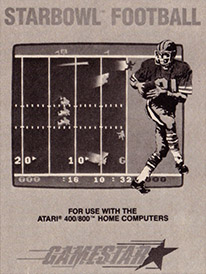
RAMblings
Computergame Reviews
SPITFIRE ACE
MicroProse Software
Atari 400/800/1200
32K, Basic Cartridge

Here’s your chance to find out what flying a W.W.II fighter plane was like…with less dire consequences, to be sure.
After loading, a menu appears. Choose your scenario from one of the following: France, Dunkirk, Fighter Sweep, Night Attack, Blitz, London, Malta, North Africa, Cologne, D-Day, V-1, Ruhr and ME-262.
Once you start, play continues until you amass five victories or lose your plane. As you survive each scenario, you automatically graduate to the next one. Before entering your plane, you will be briefed on your mission and allowed to select difficulty options.
You need two joysticks to fly your plane, one for a throttle and the other for control. The view is from out of the cockpit. Instrumentation consists of an altimeter, speedometer, compass, power setting, ammo gauge and rear view mirror. As you are flying, you can perform many maneuvers such as rolls, dives, stalls, turns, etc. The plane reacts excellently to the controls. There are daylight and night. flights available, but day flights present their own problems: when you fly into the sun, there is considerable glare. The enemy planes may also come up from behind. If this happens, you will be shot down, unless you take evasive action.
This is one of the finest flight simulations I’ve ever seen. In addition to the fourteen scenarios, there are four difficulty levels to choose from. The graphics are quite good, though they are essentially the same throughout all the scenarios. You may miss the ability to take off or land; the game does not allow for that. But it does allow you the option of bailing out, ditching your plane—which requires some fast thinking under fire.
—Lenny Nelson
FLOYD OF THE JUNGLE
MicroProse Software
Atari 400/800/1200
32K+ & Basic Cartridge

Similar to Jungle King or Jungle Hunt in theme and kin to Donkey Kong et al in gameplay, Floyd of the Jungle is an interesting cross-pollination. The most intriguing aspect is that up to four players can compete at the same time. During one-player games, the computer controls three of the players, Harpo, Chico and Grouch. You name your player, and start deep in the African Jungle. You must race against all odds through the deadly jungle to rescue the lovely Janice.
The first screen consists of seven levels. To reach Janice (on the fifth level), you must run, jump, climb ropes, dodge snakes, evade pygmy tribes and survive attacks by alligators, elephants and tigers—and you must do it faster than the three other players. On your way to the top, you can gather extra points by grabbing birds and punching out pygmies. If a player is killed, he or she must start over again at the bottom. Once a player reaches Janice, the scores are tallied and shown on an intermission screen. This screen appears after each play screen and shows the number of wins, birds captured, pygmies punched and total points.
Play screen two has eight levels and is similar to screen one except that you must go through caverns and avoid pygmy darts. Play screen three has six levels and is the most difficult. There is a river to cross, several rows of animals and treacherous snake pits. After the third play screen, the game ends.
In the highest difficulty level (the third), there are five play screens. Though gameplay is familiar, there are enough new wrinkles and doses of wit to make this a worthwhile purchase…if you’re looking for a multilevel climbing game.
—Lenny Nelson
COMBAT LEADER
Strategic Simulations
Atari 400/800/1200
48K, Machine language

Combat Leader, one of the Rapid Fire Series games from SSI, pits you and your army against a computerized foe. It simulates actual combat using tanks, vehicles, infantry men, machine guns, anti-tank weapons and mortars.
The game is broken down into several scenarios: Novice, Intermediate, Build your Own Game, Attack Enemy, Seize and Hold Position, Mobile Defense and Reconnaissance.
In the novice game, you command a platoon of five tanks. Your mission is to seek out and destroy the five computer-controlled tanks. The battle field is three screens tall (scrolling top to bottom) and consists of fields, trees, rocks, depressions, and hills. Your platoon’s defense and visibility depend upon where each tank is. You may command the entire platoon or each tank individually. As you move your tanks north (controlling speed, direction, fire, etc.), they will send you information of the dispositions of the enemy.
Throughout all the levels, the action is vivid and fast-paced. And, of course, from the novice level on, the game becomes quite complex. Be forewarned: you will have to spend some time with the instruction booklet, as the number of men, vehicles and weapons that are involved increases. Logistics also becomes an escalating concern: you will have to consider such minutiae as tank repairs and the number of men on a scouting patrol. The Build your Own Game level (design a battlefield and staff it) is a genuine plus.
This is one of the finest offerings from SSI.
—Lenny Nelson
STARBOWL FOOTBALL
Gamestar
Atari 400/800/1200
24K, Machine Language
There is a tradeoff involved with Starbowl Football; the maximum number of players per team is only six; however, each of these players is programmable, requiring your individual attention. Once the ball is snapped, gameplay is fast and frantic. Passing can be quite frustrating. If you are willing to accept those conditions, this game may be for you.
The game consists of 2-6 man teams on a horizontally scrolling screen. You have your choice of two game speeds (college or pro) and two play options (one or two player). The game starts with both teams (Red and Blue) on the field during the playing of the National Anthem. Following the Anthem, the teams line up for the kickoff. At a press of the joystick button, red kicks off to blue (you to computer). After the return man is tackled, play selection begins.

First offense: your offense consists of six men: three linemen, two receivers, and a quarterback. Play selection is made via the joystick. The selection is made in four steps. First, choose the top receiver’s pass pattern (out, screen, fly, slant in), then the blocking assignments (pass, top, bottom, trap middle), and finally the bottom receiver’s pattern. Pressing the joystick at a certain place will determine which receiver the ball is thrown to. You control the quarterback. Once in the huddle you have only thirty seconds in which to snap the ball. If you fail to do so, you will be penalized five yards for delay of game.
The most difficult and frustrating aspect of the game is passing. Pressing the button makes the quarterback throw the ball. Once the ball is released, you gain control of the receiver. Pressing the button again causes the receiver to raise his arms to catch the pass. Since the button must be hit at the exact moment the ball reaches the receiver, the odds of catching the ball if a defensive cornerback is covering you are only about 10%.
Passing takes a lot of practice and patience. But don’t get frustrated; once you master it, you may become obsessed with trying to beat the computer. Beating the computer on the college level is fairly easy if you mix your passes and runs. However, don’t expect to beat the computer in the pro game for some time. Punts, field goals, and fumbles also add to the excitement of the game.
When playing defense, you control the free safety, and select the defensive moves just as you did the offense (top defender, line rush, and bottom defender). Your free safety can roam around before the play begins. This allows for blitzes and, alas, offside penalties. It also accounts for interceptions.
Just a word of advice: When playing against the computer, the computer tends to run to the bottom of the screen most, tends to pass to the top of the screen, and can usually be sacked on third and short if you blitz (use the fly coverage for both receivers).
All things considered, Starbowl Football is an excellent game to play and fun to watch. There is even a halftime break, during which time you can go to your locker room and shout at yourself.
—Lenny Nelson
Source Pages



